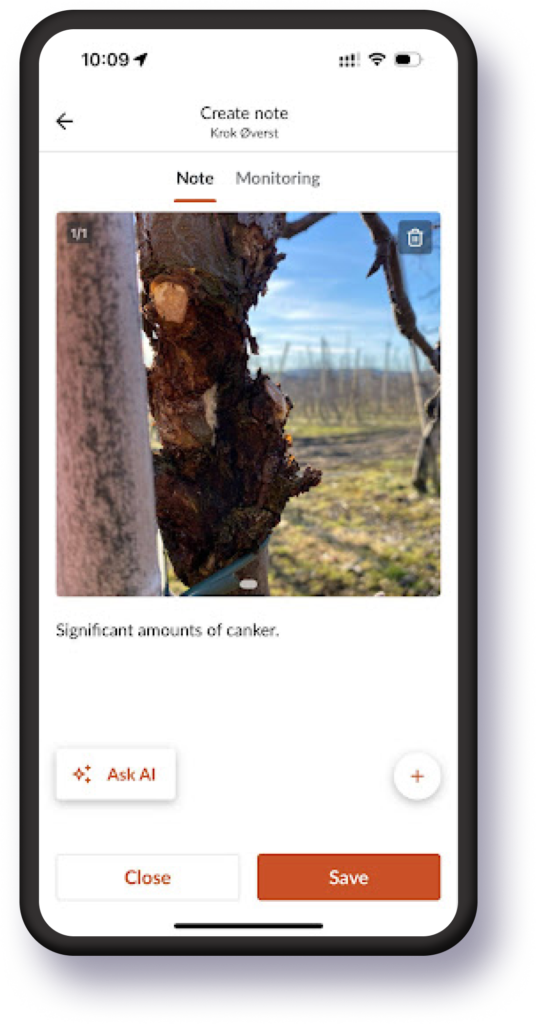Launching AI powered farm management software
Last week, Farmable launched trials for our first AI-driven features. We partnered with 30 of our most engaged users to test this initial rollout—not to convince ourselves of its value (we’re already sold on that) but to wrestle with the technical nitty-gritty of working with AI model APIs. The results so far? The possibilities are nothing short of mind-blowing.
Three Pillars of AI Analysis
Our debut implementation harnesses AI to analyze user-uploaded images, enriched with metadata from Farmable’s robust databases. We’ve zeroed in on three key functions: crop variety identification, pest and disease detection, and yield prediction.
- Crop Variety Identification: This feature is all about verification. By analyzing an image, the AI confirms that what’s growing in the field aligns with the user’s data for that plot. It’s a practical safeguard against human error and misuse, ensuring the system reflects reality.
- Pest and Disease Identification: By tapping into historical observations, crop treatments from previous years, and regional knowledge databases, it identifies pests and diseases with remarkable precision. A farmer might upload a photo of a wilting plant, and the AI could pinpoint a specific blight, drawing on years of local data to suggest actionable steps.
- Yield Prediction: The most ambitious of the trio, yield prediction shines when paired with a full dataset—imagery combined with historic yields, crop treatments, fertilizer plans, and plant health metrics. With this context, the AI forecasts yield accurately enough to guide mid-season tweaks or harvest planning. Without it, though, the predictions falter, a challenge we’re tackling in these trials.

The Power of a Digital Twin
What makes this AI work isn’t just clever algorithms—it’s Farmable’s database, a digital twin of real-world farming operations. Our primary database comprises nearly 200 interconnected objects, each nested and linked to represent real farm dependencies. With the right queries, the AI can access a panoramic view of a farm’s organization and execution—every field, every treatment, every harvest. This isn’t just data; it’s a near real time mirror of the farm.
Without this structure, we’d be back to the old siloed data problem: isolated spreadsheets, SQL databases, and disjointed insights. The digital twin approach ensures that AI doesn’t just see a single image—it understands the story behind it. For instance, identifying a pest isn’t just about the leaf in the photo; it’s about the crop’s history, the region’s pest patterns, and the farmer’s past interventions. That’s the difference between guesswork and intelligence.
The Technical Journey
These trials are a proving ground for the plumbing of AI integration. How do we optimize API calls for speed? How do we handle edge cases like uploads of wrong data? How do we force the AI to return a Farmable object like a “spray job”? Our 30 trial users are helping us fine-tune these details, and their early feedback is already shaping what’s next.
Beyond the Horizon
This is just the beginning. In the near future, we’ll expand AI’s reach across Farmable’s ecosystem. Imagine AI analyzing harvested batches to trace quality back to specific fields, or crunching satellite imagery for real-time crop health insights. We’re even planning to scan packhouse result sheets, extracting quality and price data to tie financial outcomes directly to field performance. Every step brings us closer to a fully integrated platform where AI assists farmers at every turn—automating the mundane, illuminating the complex, and driving better decisions.
The Farmable outlook
Ultimately, our goal is simple yet ambitious: use AI to improve financial performance for farmers. By weaving it into every layer of Farmable—from planning to harvest to market—we’re creating a system that works as hard as the people it serves. The trials we launched last week are a milestone, but they’re also a promise. At Farmable, AI isn’t a buzzword—it’s the backbone of a smarter, more profitable future for farming.

